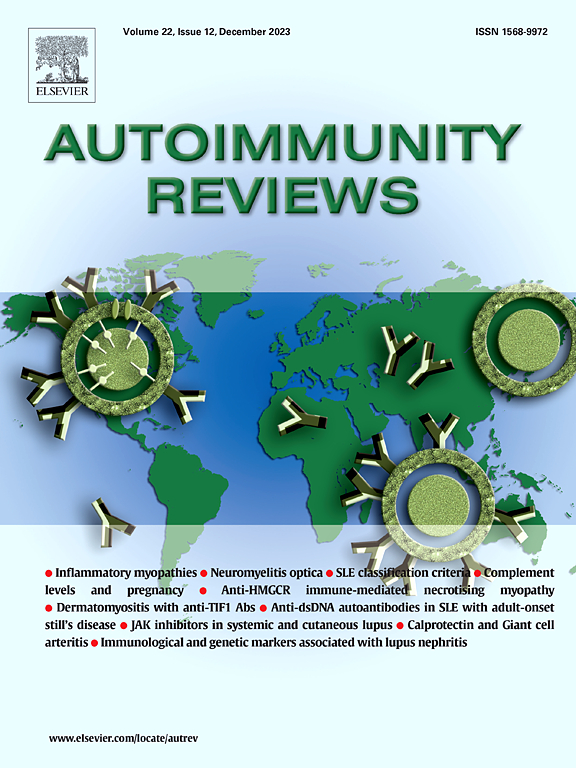免疫信号与细胞死亡的交叉:STING通路与铁下垂的双向调控机制。
IF 8.3
1区 医学
Q1 IMMUNOLOGY
引用次数: 0
摘要
STING信号通路是先天免疫系统的核心组成部分,主要负责感知胞质DNA并触发I型干扰素反应来调节先天免疫信号。最近的研究表明,除了在免疫反应、炎症和感染中发挥作用外,STING还可以通过经典或非经典信号通路调节代谢和细胞死亡。铁死亡是一种独特的铁依赖性细胞死亡形式,以细胞内铁积累和脂质过氧化为特征,与多种疾病有关,包括癌症、自身免疫性疾病、神经退行性疾病和感染。新兴的研究已经证明了STING和铁下垂之间的相关性。STING激活诱导炎症因子和细胞因子的产生,破坏铁稳态、脂质代谢和氧化平衡,从而引发铁下垂。同时,铁下垂中的GPX4、ACSL4等关键蛋白以及某些代谢产物也能影响STING信号通路的活性。这些相互作用的调控方向和信号强度显著影响疾病状态。因此,破译它们的分子机制对于制定精确的治疗策略至关重要。本文对STING信号通路与铁下垂的最新研究进展进行了综述,重点阐述了二者相互调控的分子机制。此外,我们还讨论了针对STING信号和铁下垂在疾病病理中的治疗策略,从而强调了它们在癌症和自身免疫性疾病等疾病中的潜在临床意义。本文章由计算机程序翻译,如有差异,请以英文原文为准。
Intersection of immune signaling and cell death: The bidirectional regulatory mechanism of STING pathway and Ferroptosis
The STING signaling pathway is a central component of the innate immune system, primarily responsible for sensing cytosolic DNA and triggering type I interferon responses to regulate innate immune signaling. Recent studies have revealed that, beyond its roles in immune responses, inflammation, and infection, STING can also regulate metabolism and cell death through classical or non-classical signaling pathways. Ferroptosis, a unique iron-dependent form of cell death characterized by intracellular iron accumulation and lipid peroxidation, has been implicated in various diseases, including cancer, autoimmune diseases, neurodegenerative disorders, and infections. Emerging research has demonstrated a correlation between STING and ferroptosis. STING activation induces the production of inflammatory factors and cytokines, which disrupt iron homeostasis, lipid metabolism, and oxidative balance, thereby triggering ferroptosis. Meanwhile, key proteins like GPX4 and ACSL4 in ferroptosis along with certain metabolic products can also influence the activity of the STING signaling pathway. The regulatory direction and signaling intensity of these interactions significantly impact disease states. As a result, deciphering their molecular mechanisms is critical for developing precise therapeutic strategies. Here, we provide a comprehensive overview of the latest research advances related to the STING signaling pathway and ferroptosis, with a particular emphasis on the molecular mechanisms underlying their mutual regulation. In addition, we discuss therapeutic strategies targeting STING signaling and ferroptosis in disease pathology, thereby highlighting their prospective clinical significance in conditions such as cancer and autoimmune diseases.
求助全文
通过发布文献求助,成功后即可免费获取论文全文。
去求助
来源期刊

Autoimmunity reviews
医学-免疫学
CiteScore
24.70
自引率
4.40%
发文量
164
审稿时长
21 days
期刊介绍:
Autoimmunity Reviews is a publication that features up-to-date, structured reviews on various topics in the field of autoimmunity. These reviews are written by renowned experts and include demonstrative illustrations and tables. Each article will have a clear "take-home" message for readers.
The selection of articles is primarily done by the Editors-in-Chief, based on recommendations from the international Editorial Board. The topics covered in the articles span all areas of autoimmunology, aiming to bridge the gap between basic and clinical sciences.
In terms of content, the contributions in basic sciences delve into the pathophysiology and mechanisms of autoimmune disorders, as well as genomics and proteomics. On the other hand, clinical contributions focus on diseases related to autoimmunity, novel therapies, and clinical associations.
Autoimmunity Reviews is internationally recognized, and its articles are indexed and abstracted in prestigious databases such as PubMed/Medline, Science Citation Index Expanded, Biosciences Information Services, and Chemical Abstracts.
 求助内容:
求助内容: 应助结果提醒方式:
应助结果提醒方式:


